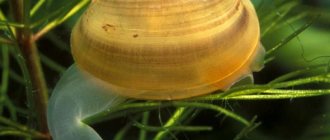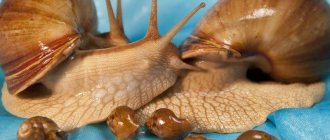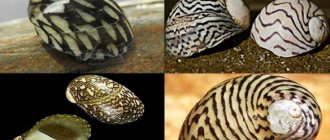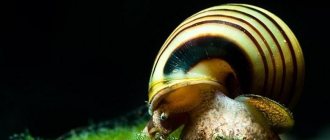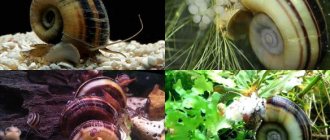Conditions of detention
They are absolutely not demanding on the quality of water in the aquarium, with the exception of one thing: their need for oxygen. Any small soil, including sand, is suitable as a soil. Water changes, aeration and filtration in the aquarium are mandatory; the recommended soil is medium sand, into which the Javan Sharovka can partially bury itself, making oscillatory movements.
Water parameters: temperature 15-30 ° C, pH 6.4-8.5, gH 10-24.
Can be kept with all peaceful, small fish and shrimp. The exceptions are: Botsia, Tetradons, Cichlids, Macrobrachium shrimp and Helena snails.
Javan Sharovka (C. javanicus) in an aquarium
This mollusk is an excellent assistant in spawning aquariums as it is a filter feeder! Its main food is protozoa and microorganisms, which it receives by passing water through itself. The process occurs as follows: water is drawn through a hole surrounded by small probes, and water is drawn through the adjacent one, which looks like a tube.
Average productivity 5 l/h. The water in aquariums with this mollusk is always crystal clear, does not bloom and does not have suspended matter. Activity is observed during daylight hours; at night, the doors are tightly closed.
The yellow Javan ball also has other obvious advantages - its doors do not open more than 3 mm. Therefore, it is impossible for the fry to get into the shell of a mollusk. The valves of the mollusk open significantly only in case of death.
Javan Sharovka (C. javanicus) nozzle mollusk
No outbreaks of disease caused by protozoa have been observed in breeding aquariums. It can be assumed that Corbicula Javanicus not only does not bring diseases into aquarium water, but also disinfects it from some pathogenic organisms that have a free-swimming stage.
Javan Corbicula snail Corbicula javanicus
Description:
Corbicula java is a small snail, which makes it suitable for keeping in an aquarium. The size of the shell of an adult snail does not exceed 3 cm, young specimens are somewhat smaller - about 1 cm. The shell of the corbicula is bivalve, round in shape. Golden bivalves have a bright yellow color, so they look very elegant in aquariums.
Mollusks are active during daylight hours. Burying into the ground and exposing part of the sink with a siphon to the surface, they open the doors to filter water. At night, their valves are closed, the mollusks are at rest.
Content:
For corbicula, a tank with a volume of at least 10 liters is selected. These snails are very unpretentious. They are undemanding to the composition and quality of water. To maintain Javan corbicula, the temperature can be maintained within 15-30 degrees, and the water parameters can be as follows: pH 6.4-8.5, gH 10-24. Lighting also doesn't matter much to them. The only prerequisite for successful keeping and breeding of bivalve mollusks is a sufficient amount of oxygen in the water. Therefore, aeration in a reservoir with these mollusks is mandatory.
In an aquarium with Javan corbicula, it is necessary to have medium-sized soil. These can be small pebbles or washed river sand. It is important that these mollusks are able to burrow into the ground, so large stones are not suitable for them. The soil layer should be at least 3 cm, but not too thick. These bivalves spend most of their time buried in the ground, and sometimes they move slowly, leaving behind a small groove in the sand.
Nutrition:
They feed on various microorganisms and algae, waste products of other inhabitants of the aquarium, and small particles of food. They eat pathogenic bacteria and protozoa that can harm the fish population of the aquarium. Therefore, diseases of aquarium fish are usually not observed in tanks with Javan corbicula.
Compatibility:
With these mollusks you can keep most types of fish, shrimp and snails in the same aquarium. They usually do not harm the corbicula. But there are also exceptions. So, you should not place them next to large cichlids, ancistrus catfish, or bots. These fish can harm sedentary mollusks. Macrobranchium shrimp are also unacceptable in the vicinity of Javan corbicula, since, despite their powerful shell, they can damage or even eat the delicate mollusk. They eat other herbivorous snails, so they should not be kept in the same aquarium as corbicula.
Beneficial features
It is believed that eating this sea healer can normalize the condition of the blood vessels and muscles of the heart. This is due to the presence of important microelements in the mollusk. The composition of the product is unique. The key components of shellfish meat are:
- taurine;
- glycine.
These substances regulate blood sugar, dissolve cholesterol plaques deposited on the vascular wall, and prevent blood clots. It is known that this product contains compounds of fluorine, iodine, and selenium. Other beneficial properties:
- Protects the liver during alcoholism. Improves the condition of patients with hepatitis of various origins.
- Relieves intoxication and removes radionuclides.
The healing properties of carbicula shell are manifested in relation to hepatocytes. Based on live or frozen shellfish, an auxiliary remedy is prepared for chronic and toxic liver damage. Corbicula extract has a hepatoprotective effect.
Based on carbicula, an auxiliary remedy is being prepared for chronic and toxic liver damage.
Aquarian "AquaFish"
Corbicula Javanicus Bivalve Corbicula Javanicus Size: 2 cm.
Bivalve molluscs are quite rare in freshwater aquariums.
More recently, aquarium enthusiasts have acquired a very interesting and very beautiful mollusk - the Javan corbicula or golden bivalve. This animal can not only become a decoration for an indoor pond, it brings tangible benefits by maintaining the purity of the water. Corbicula java is a small snail, which makes it suitable for keeping in an aquarium. The size of the shell of an adult snail does not exceed 3 cm, young specimens are somewhat smaller - about 1 cm. The shell of the corbicula is bivalve, round in shape. Golden bivalves have a bright yellow color, so they look very elegant in aquariums. Mollusks are active during daylight hours. Burying into the ground and exposing part of the sink with a siphon to the surface, they open the doors to filter water. At night, their valves are closed, the mollusks are at rest. For corbicula, a tank with a volume of at least 10 liters is selected. These snails are very unpretentious. They are undemanding to the composition and quality of water. To maintain Javan corbicula, the temperature can be maintained within 15-30 degrees, and the water parameters can be as follows: pH 6.4-8.5, gH 10-24. Lighting also doesn't matter much to them. The only prerequisite for successful keeping and breeding of bivalve mollusks is a sufficient amount of oxygen in the water. Therefore, aeration in a reservoir with these mollusks is mandatory. In an aquarium with Javan corbicula, it is necessary to have medium-sized soil. These can be small pebbles or washed river sand. It is important that these mollusks are able to burrow into the ground, so large stones are not suitable for them. The soil layer should be at least 3 cm, but not too thick. These bivalves spend most of their time buried in the ground, and sometimes they move slowly, leaving behind a small groove in the sand. They feed on various microorganisms and algae, waste products of other inhabitants of the aquarium, and small particles of food. They eat pathogenic bacteria and protozoa that can harm the fish population of the aquarium. Therefore, diseases of aquarium fish are usually not observed in tanks with Javan corbicula. Javan Corbicula are excellent orderlies for indoor ponds. With them, the water will always be crystal clear. They can be kept both in aquariums with adult fish and in nursery reservoirs, where water filtration is always difficult and the issue of hygiene is very important. After all, fry can get into a working filter, but bivalve mollusks are absolutely safe for fry. The lifespan of Java Corbicula is about 4 years, although some individuals live up to 7 years. With these mollusks you can keep most types of fish, shrimp and snails in the same aquarium. They usually do not harm the corbicula. But there are also exceptions. So, you should not place them next to large cichlids and bots. These fish can harm sedentary mollusks. Macrobranchium shrimp are also unacceptable in the vicinity of Javan corbicula, since, despite their powerful shell, they can damage or even eat the delicate mollusk. Among the aquarium species of snails there are also predators that feed on other mollusks. These are Helena snails. They eat other herbivorous snails, so they should not be kept in the same aquarium as corbicula. Water parameters: — temperature — from 15 to 30 °C; — hardness — from 10 to 24 dH; — acidity — from 6.4 to 8.5 pH. Price: 100 rub.
Cooking tips
It is necessary to prepare a decoction of shellfish correctly in order to get the maximum benefit from its use. The prepared broth strengthens the immune system and restores strength after illness. You need to make a decoction from frozen or fresh shellfish. A good and effective remedy can be obtained by dipping 5 shells in 200 ml of cold water. It is in this ratio that experts recommend preparing the decoction.
The product is boiled for 2 minutes and left on the stove for about 10 minutes. It must be prepared overnight, and in the morning take one glass on an empty stomach. You can make a decoction several days in advance. Treatment should be a course. Corbicula decoction will help people with toxic liver damage and viral diseases.
Ready-made carbicula broth strengthens the immune system and restores strength after illness
Gyrinocheilaceae
Girinocheylidae come from the carp family. Fish of this species eat plant matter both from the bottom surfaces and from the walls of the container. Considered one of the best algae fighters. They do not require special conditions of detention. In captivity they grow no more than 15 cm. The body is elongated. Reproduction is possible only in specialized nurseries. For maintenance they require additional feeding with plant foods.
Hyrinocheil fish, which clean the aquarium, have the following characteristics:
- Life expectancy in captivity is at least 10 years.
- Behavior is closer to the aggressively territorial type.
- Daytime lifestyle.
- The structural feature is that the lips are suction-shaped.
Varieties of Gyrinoheilaceae:
- Ordinary. Yellow, olive color with black specks.
- Siamese. Spotted color of orange, yellow shades.
- Gold. The body is golden in color with dark spots.
- Yellow. The main difference from the golden gyrinocheilus is the uniform yellow color, without spots or tints.
- Albino. Body color is pale pink.
- Marble. Pale brown color with black spots.
The species differ only in color; the conditions of detention and behavior are basically similar.
Minuses:
- Do not destroy red algae - blackbeard, Vietnamese.
- If the main food runs out, higher plants can eat up.
- Possible aggressive behavior towards other floating inhabitants.
Diseases:
- Obesity. The reason is an excess of additional feed.
- Fish of this family are susceptible to infectious diseases. They can become infected with parasites from other inhabitants of the aquarium.
- Poisoning and oxygen starvation are possible. The reasons are contamination of the added water with nitrate and ammonia compounds.
Hepatitis treatment
To restore inflamed liver cells, 10 to 15 shells should be placed in cold water. You will need 250 ml. After this, the product must be boiled over low heat for 2 minutes. The shells are left in the decoction until the morning, and after waking up, they drink the finished product on an empty stomach.
The Japanese have long noticed the beneficial properties of carbicula. This country even produces dietary supplements based on the product. They are available in the form of powders and capsules. People suffering from alcoholism are advised to take them to restore liver cells. Experts recommend combining this medicine with kelp powder.
Like any medicine, corbicula powder has contraindications. The main one is individual sensitivity to the product. If you have any doubts, you should consult a specialist before starting therapy.

